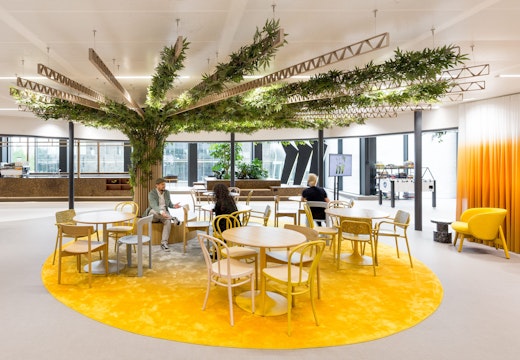Workplaces as centres for life: where work meets community
As communities rethink place in response to the global polycrisis, could the workplace evolve into a regenerative anchor for cultural, ecological and economic renewal?
In an era marked by overlapping ecological, social and economic crises, the traditional role of the workplace is being called into question. No longer just a site of productivity, the office now sits at the intersection of global challenges – from climate breakdown to community fragmentation. A new report commissioned by the Joseph Rowntree Foundation offers a compelling vision for how place can be reimagined as a driver of regeneration. At its heart is the idea of ‘Centres for Life’ which refer to central hubs that act as spaces for learning and collaboration, and as anchors for cultural, ecological and economic renewal.
Applied to the world of work, this model opens up radical possibilities. What if the workplace became more than a backdrop to business – as vital to its community as a museum, cultural hub or national park? What if workspaces became living ecosystems, designed to regenerate the people, places and processes they touch?
The post-office office
The office, once a symbol of control and uniformity, is increasingly being recast as a site of transformation. Rather than simply adapting to flexible schedules or new technologies, future workplaces are being challenged to support the regenerative needs of people, place and planet.
This means going beyond ‘green building’ checklists or wellness add-ons. A truly regenerative workplace acts as a social and ecological anchor – a place where culture is cultivated, relationships are nourished, and resources circulate with care. Think food-growing rooftops that support local biodiversity. Meeting rooms that double as public learning spaces. Procurement policies that prioritise community wealth over efficiency.
What emerges is a new spatial identity, not an office in the traditional sense, but a lifespace. These are places that don’t just house work, but host life. They give more than they take, aligning organisational success with broader cultural and environmental value.
The most progressive organisations aren’t waiting for permission. They’re prototyping models of shared ownership, energy reciprocity and biophilic repair by testing what it means to embed regeneration into the operating system of work.
In the post-office office, success won’t just be measured by square footage or occupancy rates, but by how deeply the workplace is rooted in its local ecosystem, and how effectively it supports people to thrive.
Decentralised place-readiness
As hybrid models become the norm, organisations are carefully choosing the places they invest in. But not every place is equally ready to host meaningful, collaborative, regenerative work. The report introduces the concept of ‘place-readiness’ which is the cultural, social and ecological conditions that enable transformation to take root.
This has critical implications for workplace strategy. Decentralised HQs, distributed teams and hub-and-spoke models all depend on local environments that can support productivity alongside belonging and wellbeing. That means tapping into the social infrastructure already present such as libraries, care centres, green spaces, mutual aid groups, local transit and food systems.
Too often, workspace design is imported wholesale, with little regard for the priming conditions of a neighbourhood or region. But a regenerative approach begins with context by recognising the lived histories, community dynamics and ecological assets that shape a place.
What would it mean for organisations to assess place-readiness before expansion? To co-develop workspaces with local stakeholders, or embed themselves within existing community initiatives rather than competing with them? In the hybrid era, location strategy is as much as a real estate decision as it is an ethical one.
Regenerative capability gap
The transition to regenerative workplaces requires cultivating the skills, values and mindsets needed to sustain them. The Joseph Rowntree Foundation report identifies a major barrier to systemic change: a widespread capability gap across ecological literacy, systems thinking, policy fluency and trauma-informed practice.
These gaps are mirrored inside organisations. While technical upskilling dominates workplace learning agendas, the future of work will demand the ability to navigate complexity, nurture relationships, and think across systems and time horizons.
Regenerative workplaces are, by necessity, learning environments. They prioritise professional and personal development. Some organisations are beginning to formalise this with ‘Regenerative HR’ models, embedding care, reflection and relational work into performance culture.
What emerges is a shift from extraction to cultivation. Instead of asking what employees can produce, the focus turns to what they can grow – in themselves, in their teams, and in the places they inhabit.
Employee wellbeing as community wealth
The report highlights how care-based labour, often feminised and undervalued, remains structurally unsupported across sectors. This is often reflected in how many organisations approach employee experience – with a focus on performance, and rarely on reciprocity.
A regenerative logic asks different questions. Instead of ‘How do we maximise output?’, it asks, ‘How do we invest in people so they can thrive over time?’ This shift reframes employee experience as a contributor to community wealth, as well as a benefit to the company.
It means viewing wellbeing programmes as critical infrastructure for the business. It means recognising the relational value of work – the social bonds, mutual learning, and emotional support that make teams resilient. And it means creating policies that protect time for care, restoration, and contribution beyond the organisation.
Trust infrastructure
One of the report’s strongest calls is to move beyond top-down models of service delivery toward self-determining systems that allow communities to adapt, experiment and lead.
In the workplace, this has direct implications for how teams are structured and governed. Hierarchical, output-driven models can’t respond fast enough to complex and changing environments. What’s needed is a shift to learning-based leadership, distributed decision-making, and cultures that reward reflection as much as delivery.
Some organisations are beginning to adopt flatter structures, autonomous teams and trust-based governance. But truly regenerative systems invest in capacity and care, not just control. This includes unrestricted time for learning, support for emotional labour, and a redefinition of what performance looks like in a time of uncertainty.
The workplace of the future is shifting towards a living network of relationships, learning and local adaptation. As in nature, resilience comes from diversity, autonomy and interdependence – not uniformity and scale.








